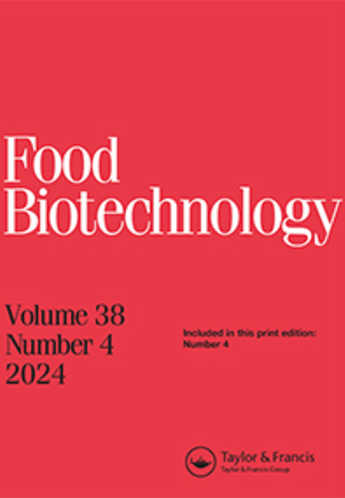Construction of Aspergillus Oryzae food-grade expression system based on auxotrophic markers
IF 1.6
4区 农林科学
Q4 BIOTECHNOLOGY & APPLIED MICROBIOLOGY
引用次数: 0
Abstract
ABSTRACT Aspergillus oryzae is an ideal host for expressing heterologous and homologous genes. Due to the risk of antibiotics to food safety, it is banned for use in resistance screening with food-grade expression system. Therefore there merit and value in exploring the use of Aspergillus oryzae food-grade expression system based on auxotrophic markers. In this study uridine/uracil auxotrophic strains A. oryzae RIB40ΔpyrG were generated by ultraviolet mutagenesis of pyrG gene deletion which would then be used as a host for further transformation analysis and applications. Meanwhile, a novel and efficient expression vector pBC-hygro.4 was constructed, which included the pyrG cassette gene, His-Tag, amyB promoter and terminator, and green fluorescent protein GFP marker. pBC-hygro.4 was successfully transferred to A. oryzae RIB40ΔpyrG via the PEG-CaCl2-mediated transformation method, and the stability of pBC-hygro.4 was evaluated by detecting the expression of the GFP reporter gene. Through phenotyping and sequencing verification, a uridine/uracil auxotrophic strains A. oryzae RIB40ΔpyrG were successfully generated. In addition, the developed vectors were fully functional for heterologous expression of the GFP fluorescent proteins in A. oryzae RIB40ΔpyrG and the recombinant A. oryzae RIB40ΔpyrG cultures indicated pronounced green fluorescence in the mycelia. Based on auxotrophic/nutritional markers, this study provides an effective method that can be applied to develop similar fungal transformation systems in other filamentous fungi, which will be beneficial for food-grade applications.基于营养缺陷型标记的米曲霉食品级表达系统的构建
米曲霉是表达异源和同源基因的理想宿主。由于抗生素对食品安全的风险,它被禁止用于食品级表达系统的耐药性筛查。因此,探索基于营养缺陷型标记的米曲霉食品级表达系统具有一定的应用价值。在本研究中,通过对pyrG基因缺失进行紫外线诱变,产生了尿苷/尿嘧啶营养缺陷型米曲霉RIB40ΔpyrG菌株,并将其作为宿主进行进一步的转化分析和应用。同时,构建了一个新的高效表达载体pBC-hydro.4,该载体包含pyrG盒基因、His-Tag、amyB启动子和终止子以及绿色荧光蛋白GFP标记。通过PEG-CaCl2介导的转化方法将pBC-hydro.4成功地转移到米曲霉RIB40ΔpyrG上,并通过检测GFP报告基因的表达来评估pBC-hhydro.4的稳定性。通过表型分析和测序验证,成功地产生了尿苷/尿嘧啶营养缺陷型米曲霉RIB40ΔpyrG菌株。此外,所开发的载体对米曲霉RIB40ΔpyrG中GFP荧光蛋白的异源表达具有完全的功能,重组米曲霉RIP40Δpyr G培养物在菌丝体中显示出明显的绿色荧光。基于营养缺陷型/营养标记,本研究提供了一种有效的方法,可用于在其他丝状真菌中开发类似的真菌转化系统,这将有利于食品级应用。
本文章由计算机程序翻译,如有差异,请以英文原文为准。
求助全文
约1分钟内获得全文
求助全文
来源期刊

Food Biotechnology
工程技术-生物工程与应用微生物
CiteScore
3.80
自引率
0.00%
发文量
15
审稿时长
>12 weeks
期刊介绍:
Food Biotechnology is an international, peer-reviewed journal that is focused on current and emerging developments and applications of modern genetics, enzymatic, metabolic and systems-based biochemical processes in food and food-related biological systems. The goal is to help produce and improve foods, food ingredients, and functional foods at the processing stage and beyond agricultural production.
Other areas of strong interest are microbial and fermentation-based metabolic processing to improve foods, food microbiomes for health, metabolic basis for food ingredients with health benefits, molecular and metabolic approaches to functional foods, and biochemical processes for food waste remediation. In addition, articles addressing the topics of modern molecular, metabolic and biochemical approaches to improving food safety and quality are also published.
Researchers in agriculture, food science and nutrition, including food and biotechnology consultants around the world will benefit from the research published in Food Biotechnology. The published research and reviews can be utilized to further educational and research programs and may also be applied to food quality and value added processing challenges, which are continuously evolving and expanding based upon the peer reviewed research conducted and published in the journal.
 求助内容:
求助内容: 应助结果提醒方式:
应助结果提醒方式:


